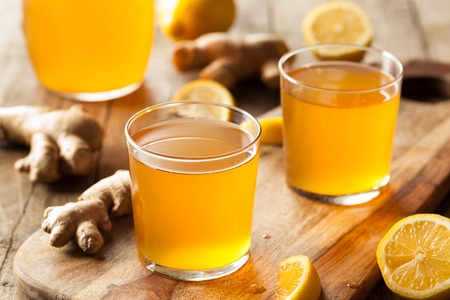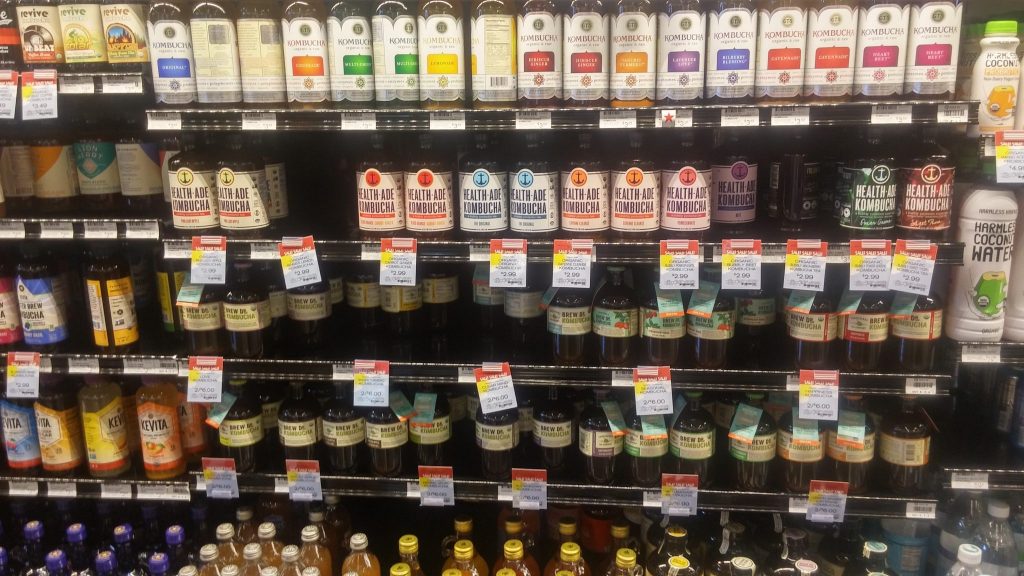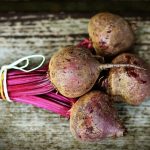
Kombucha is a fermented tea drink with a slight fizziness due to carbonation. It is highly regarded by officionados to quite categorically have a flavour similar to a weakly sparkling apple cider or even champagne. For some though, it can taste too much like a poorly developed drinking vinegar!
The flavour depends very much on the type of tea used and its taste is far removed from what we would think a fermented tea would be expected to taste like. The quality of kombucha also depends significantly on how well you look after the SCOBY that is used in the fermentation of that tea. A poorly looked after SCOBY culture and you will without doubt suffer poor taste. Why harp on about its flavour? Probably because adherents to its nutritional properties have absolute belief in its restorative powers even though claims for its efficacy are not yet firmly cast.
SCOBY by the way is short for ‘Symbiotic Culture of Bacteria and Yeast’. You might also hear others refer to kombucha as tea kvass.
In the following sections, we will discuss the history of its production, how it is made on an industrial scale and then how it is made at home. We’ve also mixed up the technicality of the format. The industrial manufacture and microbiology of kombucha is more formal than the section with references whilst the section on homebrewing this beverage is less scientific to suit. Let me know what you think!
History Behind Kombucha
Konbucha is thought to have originated in China and has been consumed there for over 2000 years. The first records come from 221 BC where it was known as ‘The Tea of Immortality’. The history relating to its benefits come mainly from anecdotal evidence as is often the case with many traditional products. It is also known by various other names including haipao, kocha kinoko, homgo, suancha or takezutsu-sancha.
Kombucha has certainly achieved popularity amongst many for its health benefits resulting from regular consumption. It should be thought of as a probiotic drink to rival yogurts and smoothies.
The beverage is said to stimulate digestion, the immune system, to improve liver function, provide detoxification and even reduce obesity and help with weight management. It is also believed to be a treatment for various chronic and acute conditions like arthritis to cancer, osteoporosis, for treating high blood pressure, neurotoxicological complaints and so on (Dufresne and Farnworth, 2000). A large Russian study claimed in the early 50s claimed that daily consumption of kombucha was correlated with a high tolerance to cancer although this remains to be proven by other studies. Unfortunately, definitive clinical studies are needed to demonstrate many of the putative health benefits.
Production & Fermentation Microbiology
Generally, kombucha is prepared by fermenting black tea which has been sweetened with sugar. In the process which can be performed at home (see later) as well as industrially, black tea leaves are infused with boiling water that is sweetened with sugar such as sucrose at a concentration between 50 and 150g/L. The whole brew is left to infuse for at least 10 minutes.
After removing the tea leaves, the brewed tea is poured into a wide-mouthed sterilized and clean vessel. It is then acidified by adding vinegar or the so called tea fungus.
The tea ‘fungus’ contains a variety of highly beneficial yeasts and bacteria and molds. This starter culture is often known as a SCOBY (symbiotic colony of bacteria and yeast). The SCOBY can be viewed as a form of probiotic culture although this is a misnomer. The manufacture of kombucha relies on bathing black or in some cases, green tea with a culture of SCOBY which looks like a rubbery disc or “mushroom”. That rubbery disc is in fact a floating cellulose mat or cellulose pellicle. It is formed from the yeast and bacteria from a previous fermentation. It does look rather unpleasant being so globulous and rather unappealing but it’s at the heart of this product.
The SCOBY cultures can be used over a number of times. The fermentation medium can also include various types of water but usually spring water, cane sugar with distilled white vinegar to reduce the pH.
The SCOBY used here is very similar to that used for kefir and water kefir. There are some practitioners who use the same SCOBY for all these types of products.
The products produced by fermentation include a variety of food acids including acetic acid (vinegar), vitamins, minerals, tea compounds and gluconic acid. The beverage is also slightly carbonated as the yeasts ferment the sugar as in a wine fermentation. Caffeine is retained in the brewing mix. The cider flavour is probably due to the presence of gluconic acid with other yeast based compounds mixed in.
The product really lends itself well to product development with a variety of flavours now available. We discuss the brands later on.
A powerful symbiotic relationship is created between the yeast and the acetic acid loving bacteria. This combination effectively inhibits the growth of any other micro-organisms including the growth of contaminating bacteria. The bacteria is mostly Lactobacillus with Acetobacter and the changes they produce are now well understood (Teoh et al., 2004; Jayabalan et al., 2007). Acetobacter xylinum was found to be the predominant bacterium in the mat. It produces both acetic and gluconic acids although a mix of bacterial species are found which all contribute their own unique flavour. You can understand why it is important to look after your SCOBY as it may be unique to you and your product. The A. xylinum also synthesizes the floating cellulosic network which is essential for the close relationship to form between it and the yeasts.
The yeasts incidentally are many and varied. We see Zygosaccharomyces kombuchaensis, Z. bailii, Z. bisporus, Z. microellipsoides, Brettanomyces, various Saccharomyes, Schizosaccharomyces pombe, Torulaspora delbrueckii, Rhodotorula mucilaginosa, Candida stellata and Brettanomyces bruxellensis. This range of yeasts have all been isolated from different SCOBY.
What Does The Tea Contribute?
Black tea is the fermentation medium of choice. All black tea is intensively processed where the leaves are warmed to the point that enzymes in the leaves turn it black. The key enzyme is polyphenol oxidase which oxidises the polyphenols present in the leaves.
If we use white or green tea, the tea is not so developed.
The Use of Sugar
We’ve discussed the SCOBY and the tea but there is another critical ingredient which makes the fermentation effective. Sugar! Adding the right amount is vital and in many cases its level of addition is more art than science. Given each SCOBY is different particularly when it is used at the household level also means that the amount of sugar needed will vary too. Sugar, a disaccharide, is added to feed the yeast and bacteria and ensure it continues to grow. The additional and equally important reason is to bring sweetness to a weakly acidic and to generate the sour flavour. Some of the sugar will be the raw material for the lactic and gluconic acid produced. The balance of flavours – sweet with sour is important in kombucha and this contributes greatly to the desirability of the beverage.
Market Research
The latest market research from Technavio shows the global kombucha market will grow by almost 15% (CAGR) from 2017 to 2021. Much of this growth is in the USA in trendy markets where it is projected to reach $1.8 billion globally by 2020. The current market is $1.2 billion worldwide. The market can be split into two product types, organic and non-organic. In 2016, the organic kombucha segment accounted for 95% of the market. The Chinese are the largest consumers of the drink in the East but this may be due to the development of the drink from this country.
Product Development Opportunities With Kombucha
Kombucha lends itself very well to the addition of juices. There has been plenty of activity in the market place with the launch of various drinks that combine kombucha with certain fruit juices that have various health properties. Suja Life LLC (Oceanside, California) now offer organic Kombucha which expands its range of beverages in this market. Their four products could be seen on the shelves in 15.2-ounce bottles. The Suja Life products are non-GMO and non alcoholic. They also use high pressure processing to pasteurise the product which extends shelf-life.
The business claims the drinks contain 5 billion colony-forming units of probiotics with several functional adaptogens. Looking at The main health claim is ‘supports immune health’.
The lineup is offered in six varieties:
- Mixed Berries Kombucha, which includes the adaptogen schizandra
- Peach Ginger Kombucha, which features the adaptogen reishi;
- Ginger lemon Kombucha, which is made with the adaptogen, ashwagandha;
- Super Green Kombucha, which contains the adaptogen moringa
- Pineapple Passionfruit Kombucha, with turmeric
- Green Apple Kombucha with amla.
The Green Apple Kombucha for example has a simple ingredient list of water, kombucha, apple juice, cane sugar, lemon juice and amla. The bacteria is inactivated Bacillus coagulans and the probiotic Lactobacillus rhamnosus. The Ginger lemon flavour appears to have a good balance between the two – a sharpness of lime citrus overlaying the cider-like notes. It seems clean and refreshing.
In Portland, Oregon, back in the summer of 2018, I was perusing the retail shelves and noticed quite a variety of products. Revive from Sonoma County in California have an extensive range too. There flavours include ginger and lime, an original cola, the hibiscus refresher and a turmeric, ginger and citrus flavoured kombucha. Mind you they also offer yerba mate with ginger, a mocha java coffee, a cucumber mint with lemon, a valencia orange & cayenne, a lemon refresher and last but not least a toasty green tea. That’s quite a collection.

Mind you if you think that isn’t big enough then try GT’s Living Foods trio of flavours from each of these four groups, Enlightened Kombucha, Enlightened Synergy, Classic Kombucha and Classic Kombucha. There are a total of 12 flavours on current standing and these really have made full use of herbs, spices, vegetable juices and much more. GT’s Living Foods is based in Beverly Hills, California.
I like Health-Ade who make the claim that there branded products are the slowest to ferment. Presumably this adds to the unique flavour in their products. they too have a flavoursome product range. I noticed a Christmas product, Holiday Cheers which a is a brew blending ginger, allspice, chocolate and more. Two other leading brands from Oregon are Brew Dr which also has a large selection to choose from and is based in Tualatin. We also have Lion Heart which is brewed in Portland, Oregon. Given the microbrewery scene over there it is not surprising they could put their fermentation skills to good use preparing this product.
In the United Kingdom we now have Go! kombucha. These products have a sophisticated appeal in screw-top wine bottles (750ml) and emphasize the type of tea fermented. They currently have Green Secha, Red Pu-Erh, China White, Yunnan Gold and Darjeeling Black. That’s also quite a clever play on colours too. The sugar content is about 4g/100ml and the energy content is between 16 and 17 cals/100ml.
I apologise to anyone I’ve missed and I would welcome the opportunity to include you in the list. In due course I intend to do a more thorough review of the brands because of the great range of flavours on offer.
Side Effects
- Do not consume if pregnant or breastfeeding.
- If you have a compromised immune system.
Few clinical studies are known which have actually demonstrated its safety, efficacy or indeed health benefits. Various stomach complains such as nausea, dizziness and stomach ache have been reported so care is needed especially with over-consumption. Keeping the fermentation going for too long can lead to a build up of organic acids in the brew. However, it is likely that this will produce too acidic tasting a product for consumption. Dilute the product if it tastes too acidic.
Always see your GP if you are concerned about introducing kombucha into your diet, or if you have any adverse side effects after consuming it.
Making Kombucha Tea At Home
Brewing kombucha at home can never be a true science. Expect variations in appearance and taste because each culture is unique and there are always subtle differences in the way each of us prepare this brew.
The equipment used in the home consists mainly of a thoroughly clean andhighly sterilized glass jar for the fermentation, and a coffee filter or weave cloth to filter out the bacteria. The jar is carefully covered with a clean cloth and secured with bands. The tea is fermented in the jar in a warm place for up to about a month although it is often ready between 10 and 12 days. The kombucha needs to be tasted at various stages to check flavour and sweetness. Some of the SCOBY should be retained for use in the next batch.
These instructions should help.
Equipment And Ingredients For Making Kombucha At Home
SCOBY discs can be purchased from Happy Kombucha to produce about a litre of fermented tea and is certified to be organic. You can also borrow SCOBY cultures from producers of kefir and water kefir.
You will also need:-
- Clean white handkerchief or a towel that can be secured with a rubber band around the top of a jug or jar.
- Glass jugs to hold a couple of pints.
- Ladles – preferably plastic or stainless steel. Could be a large deep soup spoon.
- Mason jars – 4 or 5 should be enough. These are 1 pint/475ml each and used for storing the finished product. It is best to use as broad a vessel for fermentation as possible because for kombucha to develop, it needs a large surface area and works best if the diameter of the container is greater than the depth of the liquid.
Preparing the ‘baby’
A newly purchased or obtained kombucha SCOBY which you can call a baby means that it must be removed from its plastic bag or container. Carefully lay the kombucha on a shallow glass dish and pour tea that came in the plastic bag onto the dish as well. Cover the dish with a clean white cotton towel or cloth. Don’t allow the towel to contact the culture as it causes contamination. Whilst we are careful in handling the culture they are resilient and robust and tolerate routine handling. This will also become the starter culture.
Some of you may not be able to purchase a ready made SCOBY but if you buy a couple of bottles of kombucha then use that as the starting point for it. Also look out for glass bottles with reusable lids or ones that take a crown cap because these can also be recycled. They are also designed with kombucha in mind.
To prepare the tea, purify your water and pour between 2 and 4 quarts into a good quality cleaned stainless steel pot. Bring the water to a boil. remove from the heat.
Add sugar whilst it is still hot and stir to dissolve. About 1/2 cup of sugar per quart or litre of water is ideal. You can return the pot of water to the boil to redissolve any that has not done so the first time around.
Add the tea – you can either brew the tea in the stainless steel pot or glass bowl that you will use to ferment the kombucha tea. Use 2 teaspoons of loose tea or 2 tea bags for every quart or litre of water. the amount can be varied to taste or to make the tea weaker or stronger. The steeping time is about 10 to 15 minutes. Steeping time for loose tea is shorter – about 3 to 5 minutes. Using loose tea also means it must be strained which adds to complexity in the process.
This tea becomes the raw material for the beverage and is the ‘starter’.
To begin the fermentation, take half of the kombucha starter and pour into a scrupulously clean glass jug. Add some of the ‘mother’ if you have any. This mother may float or sink but that’s not an issue. Cover the top with a handkerchief and secure with a rubber band.
The tea will ferment for between 5 and 15 days depending on the temperature, say between 20ºC/70ºF and 30ºC/85ºF. The cooler it is the slower the fermentation and some high quality ferments will be up to a month. It would be good practise in the early phase of developing experience to use taste the product from time to time and to understand the best point at which flavour is optimal.
Please note this article contains links to our affiliate marketing partner. Please read the affiliate disclosure.
References
Dufresne, C., & Farnworth, E. (2000). Tea, Kombucha, and health: a review. Food Research Int., 33(6), pp. 409-421
Jayabalan, R., Marimuthu, S., & Swaminathan, K. (2007). Changes in content of organic acids and tea polyphenols during kombucha tea fermentation. Food Chemistry, 102(1), pp. 392-398.
Teoh, A. L., Heard, G., & Cox, J. (2004). Yeast ecology of Kombucha fermentation. International Journal of Food Microbiology, 95(2), pp. 119-126.

Hey – you need to try Captain Kombucha. The one I drink has raspberry in it. It’s not bad at all for flavour. We were getting it from the WholeFoods Market in Cheltenham but it now comes online through the Super Food Market. I really like the flavour. I know this is a marketing plug but it’s worth it. Some of the other kombuchas taste like fermented cat’s pee.
Love this drink! I have it with plenty of sugar and lemon. I think they do taste like a weak vinegar at times but this is super really – better than kefir for health I believe.